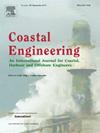三维海底地形上的孤立波演化
IF 4.5
2区 工程技术
Q1 ENGINEERING, CIVIL
引用次数: 0
摘要
本研究从实验和数值两方面对三维(3D)地形上的孤立波传播和破裂进行了全面研究。三维地形,灵感来自于Whalin(1971)实验,其特征是一个倾斜的圆形阵列,比例比为0.656。利用波浪计、声学多普勒测速仪(ADV)和成像设备,分别捕获了波浪高度、水粒子速度和波浪破碎图像。数值模拟使用了基于多相vof的求解器interFoam,该求解器具有可实现的k - i闭合模型,并通过自适应改进策略进行了增强。水粒子速度揭示了波浪演化的洞见,实验结果与数值预测基本一致。通过对比实验观测和模拟白浪区,进一步探讨了波浪破碎动力学。能量收支分析证实破波是主要的能量耗散机制,底部摩擦作用较小。总之,这项研究提供了对三维地形上孤立波行为的整体理解,将实验观察与数值模拟相结合。本文章由计算机程序翻译,如有差异,请以英文原文为准。
Solitary wave evolution over a 3D submarine topography
This study provides a comprehensive examination of solitary wave propagation and breaking over a three-dimensional (3D) topography, both experimentally and numerically. The 3D topography, inspired by the Whalin (1971) experiment, is characterized by a sloped circle array with a 0.656 scale ratio. Using wave gauges, Acoustic Doppler Velocimeters (ADV), and imaging equipment, wave elevations, water particle velocities, and wave breaking images were captured, respectively. Numerical simulations utilized the multiphase VOF-based solver interFoam with a realizable – closure model, enhanced by a customized adaptive refinement strategy. Water particle velocities revealed insights into wave evolution, with experimental findings largely congruent with numerical predictions. Wave breaking dynamics were further explored by comparing experimentally observed and simulated whitecap regions. Energy budget analysis confirmed wave breaking as the dominant mechanism of energy dissipation, with bottom friction playing a minor role. In summary, this research offers a holistic understanding of solitary wave behavior over a 3D topography, bridging experimental observations with numerical simulations.
求助全文
通过发布文献求助,成功后即可免费获取论文全文。
去求助
来源期刊

Coastal Engineering
工程技术-工程:大洋
CiteScore
9.20
自引率
13.60%
发文量
0
审稿时长
3.5 months
期刊介绍:
Coastal Engineering is an international medium for coastal engineers and scientists. Combining practical applications with modern technological and scientific approaches, such as mathematical and numerical modelling, laboratory and field observations and experiments, it publishes fundamental studies as well as case studies on the following aspects of coastal, harbour and offshore engineering: waves, currents and sediment transport; coastal, estuarine and offshore morphology; technical and functional design of coastal and harbour structures; morphological and environmental impact of coastal, harbour and offshore structures.
 求助内容:
求助内容: 应助结果提醒方式:
应助结果提醒方式:


